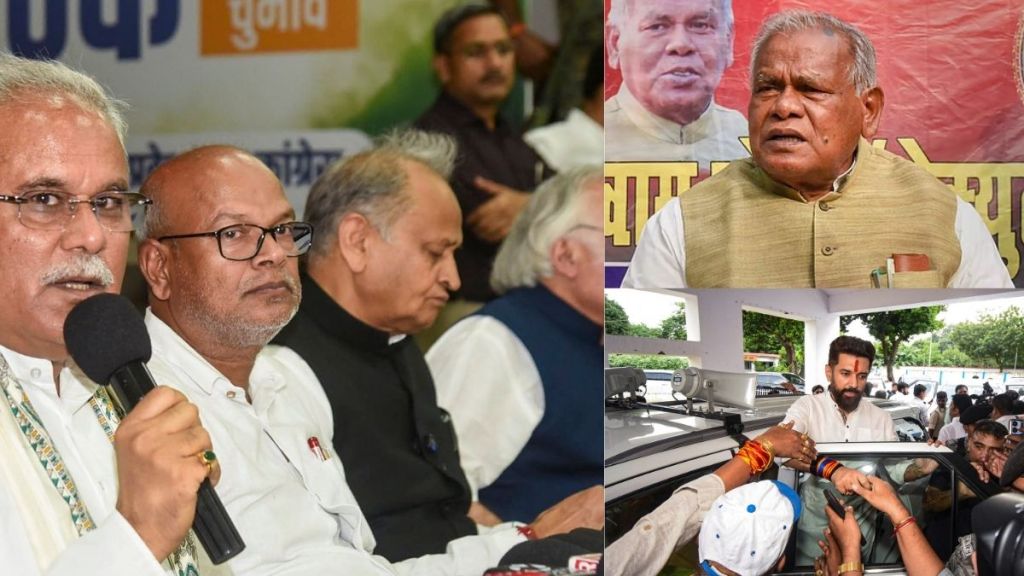Bihar Election 2025: State capital Patna is seeing huddles with leaders travelling convening meetings and travelling from one place to another to ensure all key stakeholders are intact as seat-sharing huddles take prime focus in Bihar. The state has 243 assembly seats. The Bharatiya Janata Party (BJP) has 80 with them, while Janta Dal (United) (JDU) has 45 MLAs. Tejashwi Yadav’s Rashtriya Janata Dal (RJD) has the second highest number of seats in the Bihar assembly – 77.
RJD is followed by Congress (19), CPI-ML (11), HAMS (4), CPI-M (2), CPI (2), AIMIM (1) and Independent (2).
Why is seat-sharing a challenge for the ruling NDA?
While the exact seat-sharing numbers will come to light once the parties themselves share the same, sources and reports do have a picture to project. Seat-sharing often works along the extent of the role that a party can play in an election, the strength of its candidates and its vitality in the alliance. As of now, neither the NDA or INDIA bloc can afford upsetting any of its allies.
VIDEO | Bihar Elections: When asked about reports suggesting LJP (Ram Vilas) chief Chirag Paswan is unhappy with seat-sharing in NDA, Congress leader Shakeel Ahmad Khan (@ShakeelkhanINC) says, "Such pranks happen there. But I want to ask Chirag Paswan, these things will go on, he… pic.twitter.com/jKh7eg0BUl
— Press Trust of India (@PTI_News) October 9, 2025
Backing the similar sentiment, Bihar BJP President Dilip Jaiswal on Wednesday said that “all is well” in the alliance, following a cryptic X post by Hindustani Awam Morcha (Secular) chief Jitan Ram Manjhi.
Manjhi, in a post on X, seems to have expressed his displeasure with NDA seat-sharing talks. “Ho nyaay agar to aadha do, yadi usme bhi koi baadha ho, to de do kewal 15 gram, rakho apni dharti tamaam, HAM wahi khushi se khayenge, parijan pe asi na uthayenge,” the post read.
The HAMS has reportedly asked to contest on 15 seats, but may not get more than 8-10 – the reason Manjhi is reportedly unhappy. It is being said that several sitting MLAs will not be contesting the elections this time. BJP has formed a panel to assess the seats it could not win the last time and submit a report to the central leadership.
With reports coming in that some leaders are unhappy with the formula being discussed, many say the BJP and JD(U) could be the biggest gainers when seat-sharing gets finalised in the NDA.
Chirag Paswan’s LJP (RV) has reportedly sought tickets on 40 seats but may get only 20-25. Paswan recently held meetings with top BJP leaders and Union Minister MoS Nityanand Rai also reached his residence to finalise the deal. Both Manjhi and Paswan are ministers in the Central government, and the two expect significant share in the NDA when it comes to Bihar.
Will the BJP be able to pacify the possibly angry Jitan Manjhi and Chirag Pawan? The saffron party says ‘all is well’ within the alliance.
Delhi: On seat-sharing within the NDA, Union Minister Chirag Paswan says, "It has been conveyed that everything is positive, and all details will be shared calmly" pic.twitter.com/zyfqG5cZP5
— IANS (@ians_india) October 9, 2025
Reports say the BJP has asked for 105 seats and is not likely to settle for less than 100. Similarly, Nitish Kumar’s JDU has also sought an equal ground to contest as BJP with 105 or at least 100 seats to fight elections. If the minimum is taken into account, the maths would leave only 43 seats for the other allies – the reason behind several leaders being upset.
Rashtriya Lok Morcha (RLM), reported TOI, has asked for 12 constituencies, but might not get more than 7.
The INDIA bloc picture
The scenario is no different in opposition’s Mahagathbandhan where RJD, the key player in the alliance, alone has sought to contest on 140 out of 243 seats, and will likely not agree for below 130. Congress, the big name in the coalition is likely to contest on 50-55 seats, though it has reportedly asked for 70 assembly seats.
CPI-ML, CPI-M and CPI could contest on 25, 9 and 6 seats respectively against their combined ask for 75 seats. However, the CPI-ML and Vikasheel Insaan Party (VIP) are going to be the two partners RJD will have tough time maintain the seat-sharing talks with.
Reports suggest CPI-ML wishes to contest on 30-40 seats whereas VIP too wants to fight elections on not less than 30. However, the VIP may not get more than 15 seats.
But given the maths here, CPI-ML and VIP’s demand alone count for 60 seats and if the RJD has to contest on at least 130, it leaves only 53 seats for three allies including Congress.
If the demand-supply is not met, the task for the both NDA and INDIA would be to hold their allies together. Bihar elections is not just a state electoral battle, but a test for the BJP – which is leading the Centre, and its NDA alliance. It will also be a litmus test on how far the Congress has come after last year’s Lok Sabha Elections.
This time, after the Special Intensive Revision (SIR), Bihar has 7.42 crore voters, against 7.89 crore electors as of June 24 this year. The Election Commission of India (ECI) on Monday declared the polls dates – Nov 6 and 11, and the counting of votes to be done on Nov 14. The ground is set for the intense battle in Bihar, with the main contest between ruling NDA and opposition’s INDIA bloc.
Prashant Kishor’s Jan Suraaj will be going all alone, whereas AIMIM chief Asaduddin Owaisi’s attempt to be part of the Mahagathbandhan has not been able to achieve any goal, leaving him on his own in the upcoming assembly elections.


